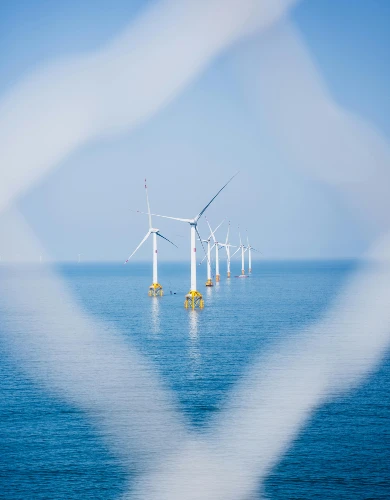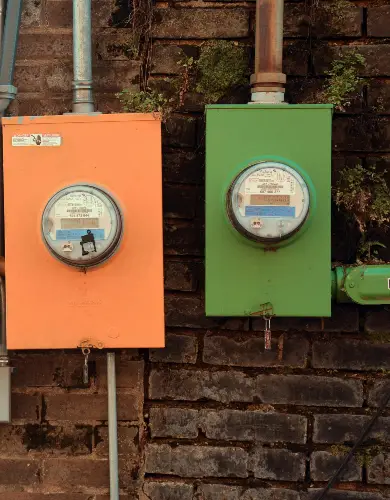Low carbon energy sources on the national grid
Britain’s energy transformation is well under way. Over the last decade, the carbon intensity of the electricity grid has plummeted from 419gCO₂/kWh to just 125gCO₂/kWh last year.
This dramatic shift reflects a national move away from fossil fuels and toward low carbon energy sources, powered by wind, solar, nuclear and innovation.
Read on to understand more about low carbon energy and the opportunities it brings for businesses.
What is low carbon energy?
Low carbon energy refers to energy sources and technologies that produce significantly fewer greenhouse gas emissions compared to conventional fossil fuels like coal and natural gas.
Carbon intensity is used to compare the emissions of different energy sources. It measures the number of grams of carbon dioxide equivalent (gCO₂e) emitted for every kilowatt-hour (kWh) of electricity generated.
In 2024, the average carbon intensity of the national grid was 125gCO₂e/kWh. This was made up of a mix of low carbon sources like wind power, which has a near zero carbon emissions, and high carbon sources like UK gas power stations, which have an intensity of approximately 400gCO₂e/kWh.
Carbon emissions thresholds
There isn’t a universally agreed-upon definition of what qualifies as low carbon energy.
The UK government’s national grid decarbonisation target aims to reduce the average carbon intensity of the grid to below 50gCO₂e/kWh by 2030.
It describes the 50gCO₂e/kWh aim as a “clean power system”, where generation will come almost exclusively from low carbon energy sources. Below, we set out which types of low carbon energy meet this definition.
How low carbon differs from zero-carbon
Zero carbon energy sources are those that produce no direct carbon emissions at the point of generation.
Wind and solar power are arguably zero carbon energy sources, although this overlooks the emissions associated with the manufacture of the equipment used for generation.
In contrast, nuclear power is a low, but non-zero, carbon source, as processing uranium fuel produces carbon emissions.
How low carbon differs from renewable energy
Renewable energy is electricity generated from sources that naturally replenish, typically using sustainable energy sources like the sun, wind or the water cycle.
Renewable energy is a subset of low carbon energy, but not all low carbon sources are renewable.
Two examples of low carbon energy sources that are not renewable are:
- Nuclear power, which relies on a finite resource of uranium.
- Gas power stations with carbon capture technology, which continue to use natural gas.
Why low carbon energy matters for businesses
There are three main reasons why British companies are transitioning to low carbon energy sources to power their operations:
Protection from volatile fossil fuel prices
The price of electricity generated from natural gas is volatile and influenced by geopolitical events. In contrast, low carbon sources offer stable and predictable prices for decades into the future.
Improved carbon reporting
The UK government requires large business energy customers to publicly report carbon emissions from energy use under the SECR framework. Adopting low carbon energy helps improve these publicly reported statistics.
Green credentials
Consumers and investors are increasingly demanding strong Environmental, Social and Governance (ESG) performance. Investing in low carbon energy generation demonstrates a clear commitment to environmental responsibility.
Low carbon energy sources
In this section, we describe the sources of low carbon energy that are currently used, or are in development for use, in the British national grid.
For each source, we’ve used the grid operator NESO’s latest statistics on its contribution.
We’ve excluded sources such as hydroelectric power, which generate less than 3% of the country’s electricity.
Wind power
In 2024, UK wind power was the single largest source of electricity generation on the grid, contributing 30%.
Onshore and offshore wind power utilises large turbines to harness the power of the wind, generating electricity with zero carbon emissions at the point of generation.
When including the carbon emissions from the manufacture, installation and decommissioning of wind turbines, the resulting carbon intensity remains extremely low, approximately 6gCO₂e/kWh.
Nuclear power
In 2024, UK nuclear power stations contributed 14% to overall electricity generation.
Nuclear power generates energy through the fission of uranium atoms, a process that does not directly produce greenhouse gases. However, its carbon intensity ranges from 15–50gCO₂e/kWh, due to emissions associated with mining and processing uranium.
As a low carbon source, nuclear plays a key role in providing baseload electricity, helping to balance the intermittent nature of wind power.
UK nuclear generation is set to remain a central part of the country’s energy mix, with the construction of the new Hinkley Point C and Sizewell C power stations, and a early stage investment in small modular reactors.
Bioenergy
In 2024, 6.8% of British electricity generation came from biomass energy sources, most of it from the controversial Drax Power Plant in Yorkshire.
The Drax Power Station combusts wood pellets, a by-product of the timber industry in the US and Canada.
Although burning wood pellets releases carbon dioxide, it is considered a low carbon energy source because the trees used were recently grown and absorbed CO₂ from the atmosphere during their growth.
As the share of renewables continues to grow, Drax Power Station is expected to play a key role in providing low carbon backup power, generating electricity on calm days when wind output falls short of demand.
Solar energy
In 2024, solar energy accounted for 5% of overall electricity generation.
Solar panels convert energy from sunlight into electricity, producing zero-emission power at the point of generation.
Optimally positioned solar panels in Europe are estimated to have a carbon intensity of 36gCO₂e/kWh. The majority of these emissions arise from the manufacturing process.
Commercial solar installation is the most common way for businesses to generate low carbon energy on site.
Carbon capture, usage and storage
The UK government is funding the development of integrated gas-fired power and carbon capture projects.
The most notable example is the Net Zero Teesside Power project, which aims to use technology that combusts natural gas while capturing 95% of the resulting carbon emissions, making it a low carbon energy source. The plant is expected to begin generating low carbon electricity in 2028.
The carbon dioxide captured as part of this project is intended to be piped offshore and permanently stored in an aquifer beneath the North Sea.
Unlike intermittent renewable sources, the Net Zero Teesside project aims to provide a flexible low carbon energy supply that contributes to grid stability.
Green hydrogen
Green hydrogen is another technology the UK government is funding to support the transition to low carbon energy.
This technology uses excess electricity generated from wind farms to produce hydrogen through the chemical process of electrolysis.
Green hydrogen can then serve as a long-duration energy storage solution, storing low carbon energy until the grid requires it. Gas-fired power stations can be easily modified to combust green hydrogen as an alternative source to natural gas.
EDF business energy is developing the pioneering Tees Green Hydrogen project, which aims to produce green hydrogen at an industrial scale using low carbon electricity from the nearby Teesside Offshore wind farm.
Low carbon energy options for businesses
Here we present the four most common options for businesses looking to transition to low carbon energy sources.
On-site low carbon power generation
Mounting an array of commercial solar panels on the roof of a large property offers one of the most cost-effective methods for generating low carbon power for on-site consumption.
Once installed, a solar panel will efficiently generate cost-free electricity with no direct greenhouse gas emissions for a lifespan of approximately 40 years.
The economic benefit of electricity generated on site can be maximised by using a commercial solar battery to reduce peak business electricity prices and maximum demand charges.
Corporate Power Purchase Agreements
A Power Purchase Agreement (PPA) is a long-term contract made directly with a renewable energy generator to purchase the low carbon electricity they produce.
Power Purchase Agreements come in two main types:
- Private wire PPA – A nearby renewable installation supplies electricity directly to your commercial premises via a dedicated cable.
- Sleeved PPA – Electricity is transmitted to your property via the national grid. A business energy supplier manages the transmission process.
For more information, visit our complete guide to purchasing electricity with a corporate PPA.
Green electricity tariffs
A green business energy tariff is a contract with an energy supplier to provide electricity certified by Renewable Energy Guarantees of Origin (REGOs).
The REGO scheme ensures that the electricity supplied to your business has been generated from a renewable source. All renewable energy sources certified under the REGO scheme are also considered low carbon.
Purchasing electricity through a green tariff is the simplest option for businesses adopting low carbon energy. Find the cheapest renewable tariff available to your company today using our business electricity comparison service.
Low carbon heating solutions
Most commercial properties still rely on a gas boiler system for heating, using a supply of natural gas from a business gas supplier.
Natural gas is not a low carbon energy source, as burning gas in a boiler produces carbon dioxide emissions.
Modern heat pump systems do not use a gas supply; instead, they run on electricity to efficiently heat a central heating system. When powered by low carbon electricity, a heat pump offers a low carbon way to heat a property.
Switching to a heat pump system also allows businesses to avoid paying business gas rates and business gas standing charges.
Government support and funding for low carbon energy
Large-scale low carbon energy generation is directly subsidised to make investment in these technologies financially viable.
Environmental subsidies are designed to accelerate the transition to net zero and stimulate investment in low carbon technologies.
The two major schemes that support low carbon energy generation are:
- Renewable Obligation – A generous subsidy for renewable projects built between 2002 and 2017.
- Contracts for Difference – A scheme that replaced the Renewable Obligation, guaranteeing a fixed price for low carbon power generation.
Both schemes are funded through domestic and business electricity bills.
The government also provides direct capital grants to support research into pilot projects for emerging technologies, such as carbon capture and the production of green hydrogen.

